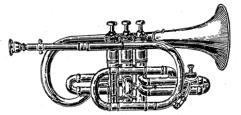Cornet
The cornet is a standard concert band instrument; most bands have at least two cornets, as they are often scored in preference to trumpets. The trumpet, however, is used more often than the cornet in orchestral, small ensemble, and solo performance. The cornet is the main high voice of the Brass band in the UK and other countries which have British-style brass bands.
Cornets and trumpets made in a given key (usually the key of B-flat, written B♭ or Bb) play at the same pitch, and the technique for playing the instruments is very similar. However, cornets and trumpets are not entirely interchangeable because the timbre (or tone quality) of their sound differs. Also available, but usually seen only in the brass band, is an Eb soprano model (often shortened to just "sop"), pitched a fourth above the standard Bb. This instrument, with usually just one in a band, adds an extreme high register to the brass band sound and can be most effective in cutting through even the biggest climax.
Unlike the trumpet, most of the tubing of which has a cylindrical bore, the tubing of the cornet has a mostly conical bore, starting very narrow at the mouthpiece and gradually widening towards the bell. The conical bore of the cornet is primarily responsible for its characteristic warm, mellow tone, which can be distinguished from the more penetrating sound of the trumpet. The conical bore of the cornet also makes it more agile than the trumpet when playing fast passages. The cornet is often preferred for young beginners as it is easier to hold, with its centre of gravity much closer to the player.
Like the trumpet and all other modern brasswind instruments, the cornet makes a sound when the player vibrates ("buzzes") his lips in the mouthpiece, creating a vibrating column of air in the tubing of the cornet that generates a musical sound. When the column of air is lengthened, the pitch of the note is lowered.
From the basic length tube of the cornet the player can produce a series of notes, like those played by the bugle, which has gaps in so that true melodic playing is impossible except in the extreme high register. So, to change the length of the vibrating column and provide the cornet with the ability to play chromatic scales, the cornet is equipped with three (or very rarely, four) valves. The action of each valve is to add a length of tubing (and thus vibrating air column) between mouthpiece and bell. As the player presses the valves, they lower the pitch of the cornet and can thus play complete chromatic scales.

The cornet in the illustration is a short model traditional cornet, also known as a "Shepherd's crook" shaped model. There also exists a long-model cornet which looks about half-way between the short instrument and a trumpet. This instrument is frowned upon by cornet traditionalists and it is not clear what its intended role is.
A troop of cavalry may also be called a cornet, so called from its being accompanied by a cornet player. Until 1871, when the office was abolished, cornet was the lowest grade of commissioned officer in a British cavalry troop, who carried the standard, also known as a cornet.